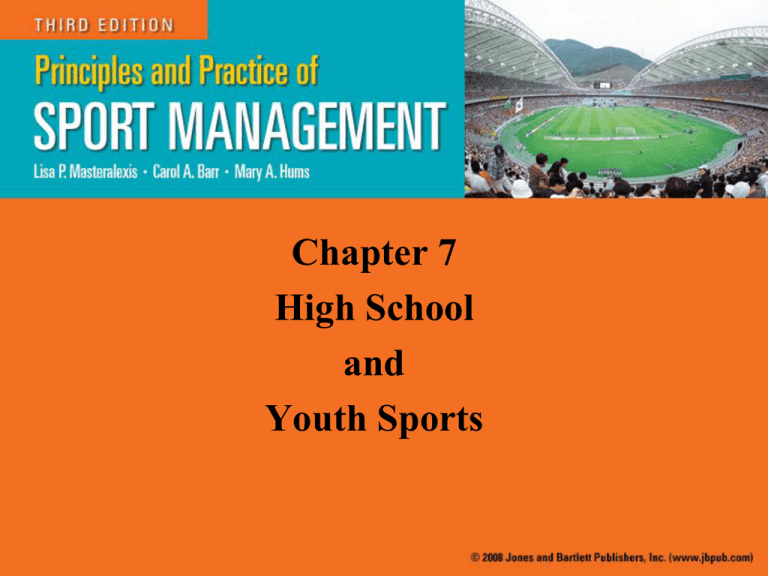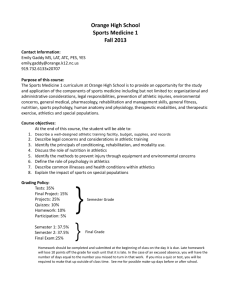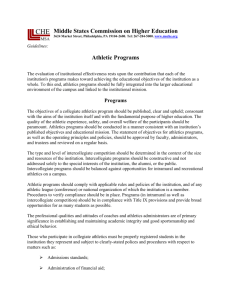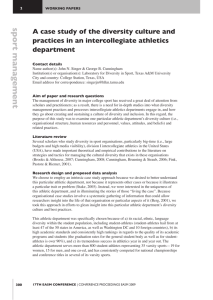Chapter 7 High School and Youth Sports
advertisement

Chapter 7 High School and Youth Sports Introduction • High numbers of children participate in youth/school sports. • Athletics provide positive influences on adolescents at a crucial juncture of their lives. • School and youth sports are the most influential sport programs in the United States. – Reflects directly on the importance Americans place on involving youth in sport activities History: School Sports • Youth athletic participation predates formation of United States and signing of U.S. Constitution. • Formally organized youth educational athletic participation did not emerge until mid-19th century. • Schools and other agencies promoted sport participation to aid in solving broad social problems such as ill health and juvenile delinquency. History: School Sports (cont.) • Public schools were slow to embrace value of exercise and play, but private schools recognized value much earlier. • Students organized games at college level. • Athletics were incorporated into school curricula (New York, Illinois, Wisconsin). • Boston-area schools formed Interscholastic Football Association in 1888. History: Twentieth Century • Progressive Movement – Educators touted athletics as tool to prepare for rigors of modern life and democracy and to assimilate immigrants into American culture – Promoted child welfare by advocating for increased playground space – Promoted formalized public school athletics as an antidote to regimented physical education curricula History: Twentieth Century (cont.) • Period during and just after World War I – School sports for males were promoted as a source of physical training for armed forces • Sports resulted in boost in school retention and graduation rates • Athletics became entrenched in schools and educators took control of athletics from students • Dr. Dudley Sargent, James Naismith, and Amos Alonzo Stagg – Significant contributions toward meeting instructional and curricular development needs History: Nonschool • YMCA: Most prominent private agency to promote youth athletics (Young Men’s Christian Association) • 1930–1950s: YMCA branches were opened in suburban areas that allowed female members • Financial calamities of Great Depression of 1930s launched unprecedented governmental involvement in recreation Governance: National Federation of State High School Associations • National coordinator for high school sports, plus activities such as music, debate, theater, and student council • Encompasses 50 state high school athletics and activity associations, as well as District of Columbia, Bermuda, Guam, St. Croix, St. Thomas, St. John, and 10 Canadian provinces • Coordinates official certification • Issues playing rules; holds national conferences and competitions; acts as advocate/lobbying agent Governance: State Associations • Replicate NFHSA model • Organize state championships and competitions in athletics and activities • Final authority in determining athlete eligibility • The scope of activities, the size of full-time administrative and support staff, and the number of schools represented vary from state to state Governance: National Youth League Organizations • Focus administrative efforts on promoting participation in a particular sports among children (e.g., Little League Baseball) – Little League 2006: 200,000 teams all 50 states plus 80 other countries participate • Require strict adherence to administrative guidelines: Standardized field size; use of uniforms and a draft system; promote adult supervision and safe play Career Opportunities: School Athletic/Youth League Director • Responsibilities – Hiring, supervising, and evaluating coaches – Coordinating facets of contest management, including hiring and paying of officials and event staff – Departmental/league training and disciplinary policies Career Opportunities: School Athletic/Youth League Director (cont.) • Responsibilities – Determining departmental/league budgets – Overseeing all associated fund-raising – Determining and verifying game scheduling and athlete eligibility – Transmitting relevant publicity and handling public relations Career Opportunities: Officials/Judges • Employed by schools and leagues but are considered independent contractors because school or league exhibits no supervisory capacity over the official • May require certification from national, state, and local sanctioning organizations • Use of unprofessional personnel (volunteers) can leave a league liable for litigation for the actions of these individuals Management • Personnel who operate school and youth sport programs are the organization’s most valuable assets and most difficult resources to attract and retain. • Because of budgetary and staffing limitations, more and more schools and virtually all youth leagues are forced to rely on athletic personnel who are not full-time employees of the organization. Financial • Administrators and coaches work together to present a detailed prediction of how funds will be spent and an accurate accounting of actual expenditures • Although school and youth sport organizations are not-for-profit enterprises, this does not mean that associated programs are not concerned with controlling costs and maintaining balanced budgets Marketing • As schools and leagues become more financially strained, coaches and administrators are often expected to be fundraisers • Such methods may include direct sponsorships donated by local businesses and individuals, the sale of items such as candy bars or other novelties, or selling advertising space in school publications or facilities Ethics • Administrators are responsible for ensuring that athletic programs treat boys and girls equally and ethically • 1990: Americans with Disabilities Act (ADA) enacted and has led to increased opportunities for athletes with disabilities Legal • Primary responsibility for any administrator is to inform staff of risks and dangers inherent in their profession. • Waiver and release of liability will not be enforceable if it attempts to insulate the school district from intentional, willful, wanton, or reckless misconduct. • Coaches are principal supervisors of the athletic activities of their teams and must provide a reasonably safe environment for participants. Summary • Organized school and youth sports have evolved from their modest beginnings in New England private schools in the early 1800s. • Administrators, coaches, and other associated personnel have developed the skills and expertise to deal with challenges and issues.











